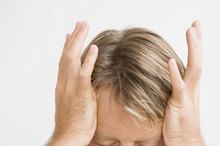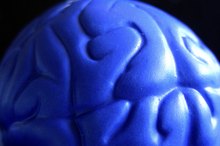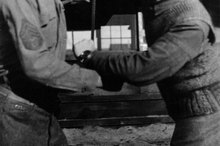What does fact checked mean?
At Healthfully, we strive to deliver objective content that is accurate and up-to-date. Our team periodically reviews articles in order to ensure content quality. The sources cited below consist of evidence from peer-reviewed journals, prominent medical organizations, academic associations, and government data.
- National Library of Medicine
- Mayo Clinic's First Aid for Head Trauma
- University of Maryland Medical Center
The information contained on this site is for informational purposes only, and should not be used as a substitute for the advice of a professional health care provider. Please check with the appropriate physician regarding health questions and concerns. Although we strive to deliver accurate and up-to-date information, no guarantee to that effect is made.
Signs & Symptoms of Head Injury After a Fall
Head injuries and trauma can be scary 2. Since the brain is located inside the skull, this is a sensitive area of the body which controls everything from motor functions, cognitive skills and much more. That is why it is so critical to recognize any signs and symptoms of a head injury after a fall so you can get medical attention right away. If you wait too long, the damage could get worse and the results could be fatal.
Headache
One of the most common symptoms of a head injury after a fall is a headache. A slight headache does not necessarily mean something is wrong, but if the headache gets gradually worse, or if it starts out as very painful, it could be a sign of a serious injury. People have died because they did not seek medical attention immediately after a fall because they thought their headache was not severe enough to be a sign of something more serious.
Read more about herbal tea for a headache.
- One of the most common symptoms of a head injury after a fall is a headache.
- A slight headache does not necessarily mean something is wrong, but if the headache gets gradually worse, or if it starts out as very painful, it could be a sign of a serious injury.
Skull Fractures
Causes of a Temple Headache
Learn More
If the fall was traumatic, there is a chance that the person has suffered a skull fracture. There are several signs that a skull fracture has occurred, including bruising around the eyes and bleeding from the nose or ear canals. A medical professional can evaluate the nerves that control the eye movements, facial muscles, hearing, sight, swallowing and other functions to help determine if there has been a skull fracture.
Nausea and Vomiting
Following a bump on the head, feeling nauseated is often the sign of a serious injury. In some cases, nausea may be associated with a concussion. If the nausea gets worse over time or turns into vomiting, the head injury could be something serious.
Read more about homeopathic remedies for nausea.
- Following a bump on the head, feeling nauseated is often the sign of a serious injury.
Memory Loss
The Disadvantages of Boxing
Learn More
With many head injuries, the person will not remember what happened just before, during and immediately after the event. In many cases, the person will never remember those events, even after receiving treatment for the injury. However, if the injury is not severe, the person will almost always recover their ability to remember and learn new things. Even in cases of amnesia, the person's memory typically returns after a period of time.
- With many head injuries, the person will not remember what happened just before, during and immediately after the event.
- In many cases, the person will never remember those events, even after receiving treatment for the injury.
Dizziness
Dizziness could be a symptom of many types of head injuries, including concussions, so you should seek medical attention any time you experience dizziness following a bump on the head.
Unconsciousness
If a person is unconscious following a fall, the head injury is probably very serious. Seek medical attention immediately.
Seizures
Seizures are typically associated with a head injury in which something has gone into the brain. Common causes of seizures following a head injury include a skull fragment breaking off and going into the brain or falling on something that pokes through the skull and enters the brain. When something like this happens, the person may suffer from seizures for the rest of his life.
Related Articles
References
- National Library of Medicine
- Mayo Clinic's First Aid for Head Trauma
- University of Maryland Medical Center
- Henry MC, Stapleton ER. EMT Prehospital Care. 3rd Ed. 2004. Mosby/Jems
- Galgano M, Toshkezi G, Qiu X, Russell T, Chin L, Zhao LR. Traumatic brain injury: current treatment strategies and future endeavors. Cell Transplant. 2017;26(7):1118–1130. doi:10.1177/0963689717714102
- Blyth BJ, Bazarian JJ. Traumatic alterations in consciousness: traumatic brain injury. Emerg Med Clin North Am. 2010;28(3):571–594.
- Solmaz B, Tunç B, Parker D, et al. Assessing connectivity related injury burden in diffuse traumatic brain injury. Hum Brain Mapp. 2017;38(6):2913–2922. doi:10.1002/hbm.23561
- Howell J, Costanzo RM, Reiter ER. Head trauma and olfactory function. World J Otorhinolaryngol Head Neck Surg. 2018;4(1):39–45. Published 2018 Mar 14. doi:10.1016/j.wjorl.2018.02.001
- Viola-Saltzman M, Musleh C. Traumatic brain injury-induced sleep disorders. Neuropsychiatr Dis Treat. 2016;12:339–348. Published 2016 Feb 15. doi:10.2147/NDT.S69105
- Synnot A, Chau M, Pitt V, et al. Interventions for managing skeletal muscle spasticity following traumatic brain injury. Cochrane Database Syst Rev. 2017;11(11):CD008929. Published 2017 Nov 22. doi:10.1002/14651858.CD008929.pub2
- Calabrò RS, Russo M, Naro A. Discussing sexual health after traumatic brain injury: an unmet need!. Innov Clin Neurosci. 2017;14(1-2):11–12. Published 2017 Feb 1.
- McInnes K, Friesen CL, Mackenzie DE, Westwood DA, Boe SG. Mild traumatic brain injury (mTBI) and chronic cognitive impairment: A scoping review. PLoS ONE. 2019;14(6):e0218423. doi:10.1371/journal.pone.0174847
- Foster, A. M., Armstrong, J., Buckley, A., Sherry, J., Young, T., Foliaki, S., & ... Mcpherson, K. M. (2012). Encouraging family engagement in the rehabilitation process: a rehabilitation provider's development of support strategies for family members of people with traumatic brain injury. Disability & Rehabilitation, 34(22), 1855-1862. doi:10.3109/09638288.2012.670028
- Ta'eed, G., Skilbeck, C. E., & Slatyer, M. (2013). Which Factors Determine Who is Referred for Community Rehabilitation Following Traumatic Brain Injury?. Brain Impairment, 14(2), 222-234. doi:10.1017/BrImp.2013.21
Writer Bio
Chad Hagy is based in southern California and he has been a full-time freelance writer since 2006. He has a Bachelor of Arts in English with a specialization in writing from the University of Michigan and his articles have been published on several prominent websites including eHow and others.









